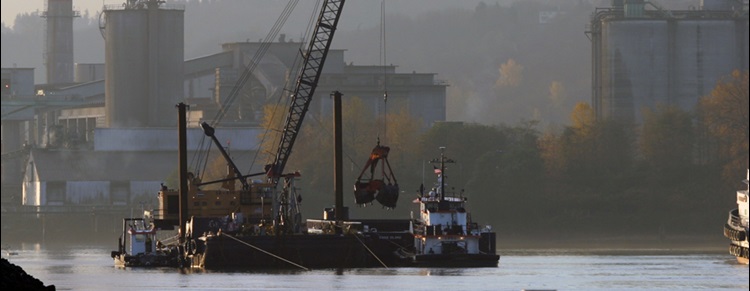
Sediment Management Program
King County's Wastewater Treatment Division is addressing sediment contamination near County CSO outfalls in Seattle through a Sediment Management Plan. The plan was developed in the late 1990s and updated in 2018 to reflect data from more recent studies. The County is investing tens of millions of dollars in cleaning up these contaminated areas. Learn more.
Early action cleanups
King County cleaned up two of the most contaminated areas within the Lower Duwamish Waterway to reduce the risk of exposure to contaminated sediment and get a head start on the Superfund cleanup.
Read more about additional early action cleanup areas cleaned up by King County’s partners .
Enhancing outdoor spaces with habitat restoration
King County has worked to restore more than 25 acres of habitat at sites in the Lower Duwamish, including the following projects. Learn more about habitat restoration along the Lower Duwamish Waterway.
- Hamm Creek Habitat Restoration Project: together with the U.S. Army Corps of Engineers, King County created 2,300 feet of new riparian stream bed and channel for Hamm Creek. The Elliott Bay/Duwamish Restoration Program designed and monitored a one-acre estuarine marsh with fish-passable connection to the Duwamish Waterway. The enhanced freshwater Hamm Creek channel features meanders, fish pools, and large woody debris. The intertidal habitat was planted with native estuarine marsh vegetation.
- Herring's House Park and Intertidal Habitat Restoration Project. This project was named for a Native American longhouse village that once thrived there. The work has included removal of mill structures, a shoreline dock, and contaminated sediments. A 1.8 acre intertidal bay was created, with fringing emergent vegetation in an intertidal zone. Riparian vegetation was also planted to create a riparian buffer.
- King County's Cecil B. Moses Memorial Park: At this location extensive mixing of fresh and salt waters creates a key transition zone for young salmon moving downstream to Puget Sound. Restoration work included a one-acre basin with fenced-off slough and marsh created to increase off-channel habitat
- North Wind's Weir Restoration Project: This project across from Cecil B. Moses Park is two acres of off-channel wetlands and sloughs, and in-stream shallow and slow water habitat to provide off-channel habitat for out-migrating salmonids. Marsh, emergent and riparian vegetation has been planted.
- Turning Basin No. 3. Restoration project. This project is located on the former Kenco Marine Services property. An old building, dock, and grounded barges were removed. Fill material was removed to push back the shoreline. Marsh and riparian vegetation were planted.
- South Park Bridge. When King County opened a new bridge to replace the old deteriorating structure closed in 2010, King County also restored 300 feet of shoreline habitat, replacing rip rap bank with emergent and riparian vegetation. The project also included drainage improvements and rain gardens to improve runoff quality.
- Habitat Stewardship. A long-term stewardship program was established to keep the habitat from degradation by invasive plants and damage. The program works with local volunteer groups to conduct inspection, maintenance, monitoring, and vegetation management while building community bonds with the sites.
Volunteer planting event at Duwamish Hill Preserve in Tukwila, November 2016
King County has worked to restore more than 25 acres of habitat at sites in the Lower Duwamish, including the following projects. Learn more about habitat restoration along the Lower Duwamish Waterway.
-
Hamm Creek Habitat Restoration Project: together with the U.S. Army Corps of Engineers, King County created 2,300 feet of new riparian stream bed and channel for Hamm Creek. The Elliott Bay/Duwamish Restoration Program designed and monitored a one-acre estuarine marsh with fish-passable connection to the Duwamish Waterway. The enhanced freshwater Hamm Creek channel features meanders, fish pools, and large woody debris. The intertidal habitat was planted with native estuarine marsh vegetation.
-
Herring's House Park and Intertidal Habitat Restoration Project. This project was named for a Native American longhouse village that once thrived there. The work has included removal of mill structures, a shoreline dock, and contaminated sediments. A 1.8 acre intertidal bay was created, with fringing emergent vegetation in an intertidal zone. Riparian vegetation was also planted to create a riparian buffer.
-
King County's Cecil B. Moses Memorial Park: At this location extensive mixing of fresh and salt waters creates a key transition zone for young salmon moving downstream to Puget Sound. Restoration work included a one-acre basin with fenced-off slough and marsh created to increase off-channel habitat
-
North Wind's Weir Restoration Project: This project across from Cecil B. Moses Park is two acres of off-channel wetlands and sloughs, and in-stream shallow and slow water habitat to provide off-channel habitat for out-migrating salmonids. Marsh, emergent and riparian vegetation has been planted.
-
Turning Basin No. 3. Restoration project. This project is located on the former Kenco Marine Services property. An old building, dock, and grounded barges were removed. Fill material was removed to push back the shoreline. Marsh and riparian vegetation were planted.
-
South Park Bridge. When King County opened a new bridge to replace the old deteriorating structure closed in 2010, King County also restored 300 feet of shoreline habitat, replacing rip rap bank with emergent and riparian vegetation. The project also included drainage improvements and rain gardens to improve runoff quality.
-
Habitat Stewardship. A long-term stewardship program was established to keep the habitat from degradation by invasive plants and damage. The program works with local volunteer groups to conduct inspection, maintenance, monitoring, and vegetation management while building community bonds with the sites.

 Translate
Translate